453 results
Other (science) laboratories for Microsoft Word
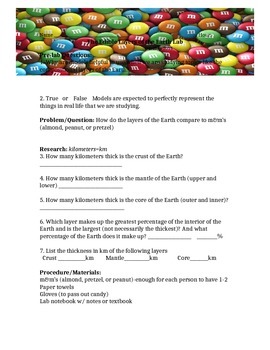
The Edible Layers of the Earth Lab
This is easy and pretty much all you need is to buy is a bag of m&m's!
My students loved this and made great connections between the actual layers of the Earth and how it correlates with m&m's. There is also an answer key included. Very easy to follow directions.
Grades:
6th - 9th
Types:
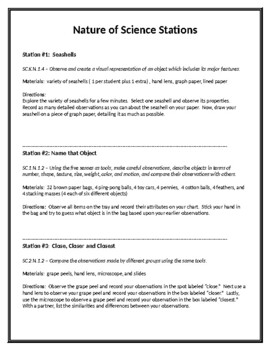
Nature of Science Observations and Inferring Inferences - 6 Stations Centers
This file is a 23 page document composed of 6 difference Science centers/stations. These stations focus on making observations, inferring based on observations, and recording observations in charts/tables. There are two pages, for teacher reference, explaining the stations, as well as the Florida Benchmark (K-5) associated with each station. Each station has a one page of student friendly directions, one page of 2-3 questions, and one page of answers for the teacher. Some stations also include a
Subjects:
Grades:
2nd - 6th
Types:

Lactase Enzyme Lab
This lab demonstrates both the specificity and denaturation of the lactase enzyme. This is a true kitchen-chemistry lab- the only required materials are skim milk, lactase tablets (from the pharmacy aisle), and glucose test strips. The lab is fully editable. To simplify the lab or to shorten it for just one class period, I suggest removing "Part 2". A pre-lab worksheet, teacher preparation notes, expected results, and possible modification/extension are included.
Subjects:
Grades:
8th - 10th
Types:
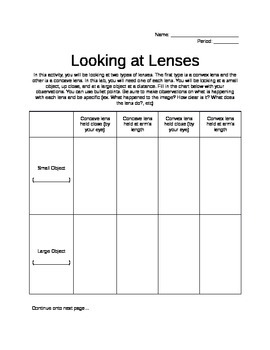
Convex and Concave Lenses Activity
The lab activity requires the use of concave and convex lenses. I use simple small ones that are cheap and easy to buy. In addition, you need to have a small object (penny, pair of dice, etc) and a large object (cabinet, door, tv, etc) for students to examine. They will stay at their desks and use the concave and convex lenses to look at each item (once holding the lens close and once holding it at arm's length). Students will write their observations on the chart provided. Then, students will a
Grades:
3rd - 11th
Types:
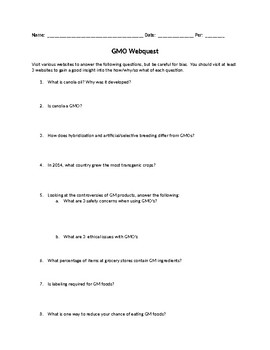
GMO Webquest
Webquest activity that explores GMOs and also addresses identifying bias in research.
Subjects:
Grades:
9th - 12th, Higher Education
Types:

Halloween Mystery Lab
In this lab activity students will investigate how drop height of a substance affects the diameter of a splattered droplet. They will utilize the scientific method to conduct this experiment which will actively engage middle school science students! Students LOVE this!
Subjects:
Grades:
6th - 8th
Types:

Crime Scene Bundle
This bundle contains labs and activities to teach students how to solve a crime scene. Teach your students hands-on, real-life science by teaching them how to conduct search patterns, how to fingerprint suspects, interview suspects, write crime scene reports, analyze hair, sketch crime scenes, how to read blood spatter patterns and so, so much more. This unit ends with you setting up a crime scene (scenario included in bundle) and having your students solve the mystery of “Murder in a Small Town
Subjects:
Grades:
9th - 12th
Types:
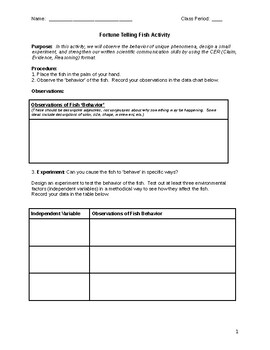
CER (Claim, Evidence, Reasoning) Introduction - Fortune Telling Fish Activity
This is a great Back to School activity which encourages experimental design and critical thinking. Students place plastic 'fortune telling fish' in their hands and make observations. 'Fish' can be purchased at Flinn Scientific or Amazon. Also visit Flinn Scientific (Fortune Teller Fish) for a detailed explanation of the science. These fish are hygroscopic polymers which change shape (ex: curl tail, flip over) based on moisture. First, students record observations. Second, students design
Subjects:
Grades:
6th - 8th
Types:
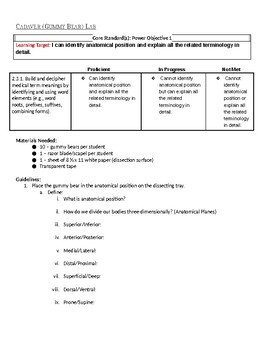
Gummy Bear Dissection Lab-Anatomical Terminology
This lab is useful for an introduction to anatomical positioning and medical terminology. I use it with my Biomedical Science class and it could be scaffolded to be more difficult with an A&P 1 class. It uses gummy bears and asks the students to both draw and dissect them in various positions and directions.
Subjects:
Grades:
9th - 12th, Higher Education
Types:
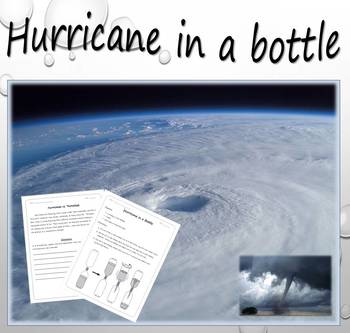
Hurricane in a Bottle Experiment
This is a 1 day experiment that allows students to reproduce a hurricane in a bottle. All directions are provided with a brief description of hurricanes & tornadoes. A follow up question is also included that engages students to analyze how a tornado and hurricane form in different ways and why this experiment is more like a hurricane.Please leave a comment and rating to let me know how this experiment worked in your classroom!
Grades:
2nd - 9th
Types:

Mass, Volume, Density Task Cards/Lab Activity
Mass, Volume, Density Assessment Lab ActivityThis packet contains 14 Task Cards for students to complete on the concepts of finding mass, volume, and density. I suggest laminated the tasks cards so that you can reuse them from year to year. You can also use different materials depending on what you have available in your classroom, just be sure to edit the Word document to fit the changes you may have made. Set up the task cards around the classroom. Students rotate through the 14 stations a
Grades:
4th - 9th
Types:

Music and Heart Rate Lab
Looking for a new way to introduce lab process and scientific method? Use this lab as a great way to show students how science is done! This lab helps incorporate students love of music with scientific principles. By having the students listen to a variety of different tunes and measuring their pulse before and after each one, it attempts to answer the question, "Does music have an effect on your heart rate?"
In short, easy to understand sections, this lab walks students through the sci
Subjects:
Grades:
7th - 10th
Types:

Saving Fred: Teaching the Scientific Method and Teambuilding
Learning Goals: Students will learn the scientific method, define a problem using appropriate reference materials to support scientific understanding, plan and carry out scientific investigations of various types, such as systematic observations or experiments, identify variables, collect and organize data, interpret data in charts, tables, and graphs, analyze information, make predictions, and defend conclusions.Students have to work together to SAVE FRED. However, they cannot use their bare ha
Grades:
Not Grade Specific
Types:
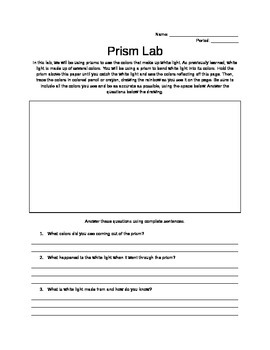
Prism Lab
In this introductory activity, students will be using prisms to bend white light in to the colors of a rainbow. They will be asked to draw their 'rainbows' on the paper and answer some comprehension/extension questions. Directions are included on activity.
Grades:
4th - 9th
Types:
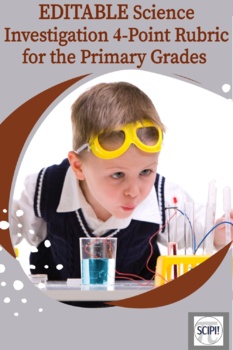
Science Investigation Four Point Rubric for the Primary Grades - EDITABLE
This EDITABLE science investigation rubric for the primary grades follows the Scientific Method and covers six areas: Exploration, Question, Prediction, Plan, Data Collection and Display, and Conclusion. It is based on a four point grading system with a column for “No Score”. It is set up so you can easily grade your students' science investigations. Since this resource is not saved in a PDF form, you can change the grading system by simply downloading the rubric and inserting your own.You mig
Subjects:
Grades:
1st - 3rd
NGSS:
K-2-ETS1-1
, 3-5-ETS1-3
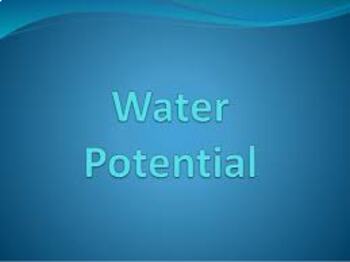
AP Biology Lab 4: Water Potential Practice Using Sample Data
This is an activity I have used for years in my classroom that has proven to be extremely effective in helping students understand how to calculate water potential in various situations. It will also help students predict direction of water flow based on water potential values. In this activity, students will graph sample data pertaining to percent change in mass for both a potato and zucchini. Using the graph, students will then determine water potential for the plants. In addition, there are
Subjects:
Grades:
9th - 12th, Higher Education
Types:

Iguana Dissection Guide
When I couldn't find a dissection guide for my high school Zoology class, I decided to create one. This is a simple, but thorough dissection guide that can be used as is, or can be modified to fit your particular needs.
Subjects:
Grades:
9th - 12th
Types:

Tug-of-War Physics Lab
Not only will students have fun playing tug-of-war, they will also be mastering the physics behind it!
Students will use tug-of-war to determine the physics behind winning! Students will play tug-of-war and research friction, gravity, forces, and net forces to determine how to win a game of tug-of-war. Included is a data and observation sheet for students to complete and a write-up for students to show what they've learned. You'll also get a rubric and instructions to help guide your lab!
Subjects:
Grades:
6th - 11th
Types:

First 8-9 Weeks of Aquatic Science Course (Schedule included)
First 9 weeks of my Aquatic Science Lab Manuel! Consists of guided lecture notes (get lectures in bundle or sperate), activities, lab activities. VERY HANDS ON.Designed to be left in the classroom. Checked for completion daily (little boxes at the bottom of each day is for a signature or stamp... I have fish stamps...). Designed to have weekly quizzes as summative grades (rather than semester tests). This first 9 weeks does have a practical exam (study guide attached). Most resources needed can
Subjects:
Grades:
9th - 12th
Types:

Urinalysis Lab
In this "hands-on" lab, students are given "samples" of fake urine to test and then determine which urine belongs to which patient. It's a fun way to formatively assess student knowledge of urine formation and how diseases affect the nephron. You can order fake urine from Carolina Biological Supply, but I make my own urine. The recipe for each "urine" sample is also included in the lab! You will need to order the following though: ph strips, glucose and protein strips, specimen cups (optional).
Subjects:
Grades:
10th - 12th, Higher Education
Types:
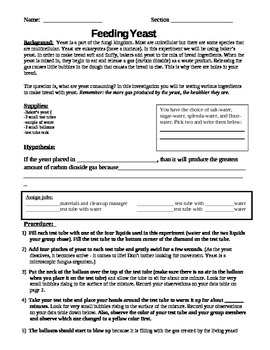
Feeding Yeast (Fungi) Lab Life Science
A complete lab activity from start to finish
Background -- In this experiment students will be using baker’s yeast. In order to make bread soft and fluffy, bakers add yeast to the mix of bread ingredients. When the yeast is mixed in, they begin to eat and release a gas (carbon dioxide) as a waste product. Releasing the gas causes little bubbles in the dough that causes the bread to rise. This is why there are holes in your bread.
Students use yeast in different water solutions (ie:flour water,
Subjects:
Grades:
5th - 9th
Types:

Chemistry pH Candy Labs and Guided Reading High School Science
Are you looking for a fun way to introduce pH to your High School Science students? Here is the lesson you have been looking for to teach your students about pH. Use Candy for 2 fun lessonsKey Terms The Arrhenius andThe Bronsted-Lowry Definitions This product includesGuided Reading2 Fun low Prep Candy labsQuestionsGraphic Organizer on food pH
Subjects:
Grades:
9th - 10th
Types:
NGSS:
HS-PS1-2

Pond Water Lab: Observing an Ecosystem (for Ecology)
This simple lab gives students an opportunity to measure abiotic factors (temperature, pH, and dissolved oxygen) and biotic factors (microorganisms) of pond water. Just stop by a local pond and get a pail of pond water. Pour a little of the water into empty baby food jars to distribute to students. Give them tools, then enjoy watching your students discover this microscopic world! Can they find any "pond critters?" They should! Then, ask them to use the "Pond Critter" sheet to identify the
Subjects:
Grades:
9th - 12th
Types:
Also included in: Ecology COMPLETE CHAPTER BUNDLE (for Chapter Two)
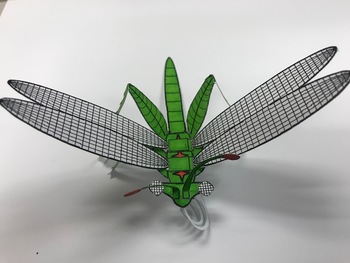
Build an insect
Students learn about the basic parts of an insect while creating one of their own from a printout of various insect parts. Students learn about the head, thorax, & abdomen. Students then learn about the various structures found on the heads of insects (eyes, mouth-parts, & antenna. Students then learn about the wings, & legs. Finally they can add structures such as stingers or cerci.
Subjects:
Grades:
6th - 12th
Types:
Showing 1-24 of 453 results





